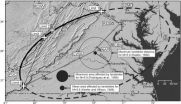(Press-News.org) If you look old, your heart may feel old, according to research presented at the American Heart Association's Scientific Sessions 2012.
In a new study, those who had three to four aging signs — receding hairline at the temples, baldness at the head's crown, earlobe crease, or yellow fatty deposits around the eyelid (xanthelasmata) — had a 57 percent increased risk for heart attack and a 39 percent increased risk for heart disease.
"The visible signs of aging reflect physiologic or biological age, not chronological age, and are independent of chronological age," said Anne Tybjaerg-Hansen, M.D., the study's senior author and professor of clinical biochemistry at the University of Copenhagen in Denmark.
Researchers analyzed 10,885 participants 40 years and older (45 percent women) in the Copenhagen Heart Study. Of these, 7,537 had frontoparietal baldness (receding hairline at the temples), 3,938 had crown top baldness, 3,405 had earlobe crease, and 678 had fatty deposits around the eye.
In 35 years of follow-up, 3,401 participants developed heart disease and 1,708 had a heart attack.
Individually and combined, these signs predicted heart attack and heart disease independent of traditional risk factors. Fatty deposits around the eye were the strongest individual predictor of both heart attack and heart disease.
Heart attack and heart disease risk increased with each additional sign of aging in all age groups and among men and women. The highest risk was for those in their 70s and those with multiple signs of aging.
In the study, nurses and laboratory technicians noted the quantity of gray hair, prominence of wrinkles, the type and extent of baldness, the presence of earlobe crease and eyelid deposits.
"Checking these visible aging signs should be a routine part of every doctor's physical examination," Tybjaerg-Hansen said.
###
Co-authors are Mette Christoffersen, Ph.D. candidate; Ruth Frikke-Schmidt, M.D.; Peter Schnohr, M.D.; Gorm Jensen, M.D.; and Borge Nordestgaard, M.D. Funding information and author disclosures are on the abstract.
Learn your heart attack and heart disease risks or view an animation of a heart attack.
Follow news from the American Heart Association's Scientific Sessions 2012 via Twitter: @HeartNews.
Statements and conclusions of study authors that are presented at American Heart Association scientific meetings are solely those of the study authors and do not necessarily reflect association policy or position. The association makes no representation or warranty as to their accuracy or reliability. The association receives funding primarily from individuals; foundations and corporations (including pharmaceutical, device manufacturers and other companies) also make donations and fund specific association programs and events. The association has strict policies to prevent these relationships from influencing the science content. Revenues from pharmaceutical and device corporations are available at heart.org/corporatefunding.
Note: Actual presentation is 4:30 p.m. PT, Tuesday, Nov. 6, 2012 in Room 502b.
All downloadable video/audio interviews, B-roll, animation and images related to this news release are on the right column of the release link at http://newsroom.heart.org/pr/aha/_prv-telltale-visible-signs-of-aging-239569.aspx.
Video clips with researchers/authors of studies will be added to the release links after embargo.
General B-roll and Photos
Telltale visible signs of aging may predict heart disease
Abstract 15333
2012-11-06
ELSE PRESS RELEASES FROM THIS DATE:
High blood pressure in young adults likely to go undiagnosed
2012-11-06
Adults 18-24 years old with high blood pressure were 28 percent less likely to be diagnosed during doctor visits than those 60 and older, according to findings presented at the American Heart Association's Scientific Sessions 2012.
"These young patients come to the clinic and their blood pressure is recorded," said Heather Johnson, M.D., lead researcher of the study. "They have high blood pressure, but there's no documentation of a diagnosis. We wanted to find out why."
Researchers examined electronic health records of 13,593 men and women who were at least 18 years ...
Heart-related deaths increase in winter regardless of climate
2012-11-06
No matter what climate you live in, you're more likely to die of heart-related issues in the winter, according to research presented at the American Heart Association's Scientific Sessions 2012.
"This was surprising because climate was thought to be the primary determinant of seasonal variation in death rates," said Bryan Schwartz, M.D., lead author of the study.
Researchers at Good Samaritan Hospital in Los Angeles analyzed 2005-08 death certificate data from seven U.S. locations with different climates: Los Angeles County, Calif.; Texas; Arizona; Georgia; Washington; ...
Drug trio improved effectiveness of cancer treatment, protected heart
2012-11-06
Combining cancer medication with a drug for erectile dysfunction and one for heart transplants helped kill cancer cells and protected the heart from damage, in a study presented at the American Heart Association's Scientific Sessions 2012.
For decades, doxorubicin has been a powerful anti-cancer treatment for various human cancers, including breast, ovarian, colon and prostate. But its use has been limited due to harmful, possibly irreversible effects on the heart.
In this study, using cell and animal models, researchers found that sildenafil alone or in combination with ...
2011 Virginia quake triggered landslides at extraordinary distances
2012-11-06
The 2011 Mineral, Virginia M-5.8 earthquake was felt over an extraordinarily large area. A new study details landslides triggered by the earthquake at distances four times greater and over an area 20 times larger than previously documented for M-5.8 earthquakes worldwide.
The study, to be published in the December issue of the Bulletin of the Seismological Society of America (BSSA), describes physical confirmation of previous observations that ground shaking from earthquakes in the eastern U.S. travels farther than in the western U.S, a plate-boundary region.
U.S. ...
Surprising findings from NHLBI Exome Sequencing Project reported
2012-11-06
A multi-institutional team of researchers has sequenced the DNA of 6,700 exomes, the portion of the genome that contains protein-coding genes, as part of the National Heart, Lung and Blood Institute (NHLBI)-funded Exome Sequencing Project, one of the largest medical sequencing studies ever undertaken.
Scientists participating in the project initially expected that individual rare variants would have a greater effect on over 80 heart, lung and blood related traits and diseases of high public health significance, said Suzanne M. Leal, Ph.D., professor and director, Center ...
New study finds that 75 percent of patients taking popular blood-thinners are getting wrong dose
2012-11-06
SALT LAKE CITY – Cardiology researchers at the Intermountain Medical Center Heart Institute have found that approximately 75 percent of patients taking two common blood-thinning drugs may be receiving the wrong dosage levels, according to a new study.
This could put them at risk for serious problems like uncontrolled bleeding or developing blood clots.
Millions of Americans with coronary artery disease take one of the two drugs — clopidogrel (Plavix) and prasugrel (Effient) — to prevent harmful blood clots that can cause a stroke or heart attack. Current guidelines ...
Researchers discover immune pathway
2012-11-06
Researchers from Aarhus University, Denmark, have now discovered an important mechanism behind one of our most fundamental lines of immune function. The discovery has been published in the esteemed scientific journal, The Journal of Immunology, where it has been highlighted as a top story.
In collaboration with colleagues from USA and Turkey, they have discovered exactly which enzymes collaborate in the first line of the immune defence. Thus, they answer a central question about the so-called complement system, which has been a focal point of the scientific field for the ...
Clever cockatoo with skilled craftmanship
2012-11-06
VIDEO:
Figaro, a Goffin's Cockatoo, makes and uses a tool.
Click here for more information.
Goffin's cockatoos are a highly playful and curious Indonesian cockatoo species. Therefore, cognitive biologists are now using them as a model species to investigate intelligent behaviour in birds. Together with researchers from the University of Oxford, Alice Auersperg and Birgit Szabo from the Department of Cognitive Biology at the University of Vienna have made a sensational discovery: ...
A new computational method for timing the tree of life
2012-11-06
With its deeply embedded roots, sturdy trunk and dense profusion of branches, the Tree of Life is a structure of nearly unfathomable complexity and beauty. While major strides have been made to establish the evolutionary hierarchy encompassing every living species, the project is still in its infancy.
At Arizona State University's Biodesign Institute, Sudhir Kumar has been filling in the Tree of Life by developing sophisticated methods and bioinformatics tools. His latest research, which appeared on the advance online edition of the Proceedings of the National Academy ...
A new development in the relief of spasms related to amyotrophic lateral sclerosis
2012-11-06
Amyotrophic lateral sclerosis (ALS) is a neurodegenerative disease with an occurrence rate in France similar to multiple sclerosis (two to three new cases per year for every 100,000 residents). It has a specific affect on neurons responsible for motor control, in particular motor neurones and central motor neurones. The former, located in the spinal cord, are directly linked to muscles and are used for muscle contraction and stretching. The latter, located in the brain, receive movement orders. As the disease develops, the neurons degenerate and the muscles are no longer ...
LAST 30 PRESS RELEASES:
This new understanding of T cell receptors may improve cancer immunotherapies
A new fossil face sheds light on early migrations of ancient human ancestor
A new immunotherapy approach could work for many types of cancer
A new way to diagnose deadly lung infections and save lives
40 percent of MRI signals do not correspond to actual brain activity
How brain-inspired algorithms could drive down AI energy costs
Gum disease may be linked to plaque buildup in arteries, higher risk of major CVD events
Contrails are a major driver of aviation’s climate impact
Structure of dopamine-releasing neurons relates to the type of circuits they form for smell-processing
Reducing social isolation protects the brain in later life
Keeping the heart healthy increases longevity even after cancer
Young adults commonly mix cannabis with nicotine and tobacco
Comprehensive review illuminates tau protein's dual nature in brain health, disease, and emerging psychiatric connections
Book prepares K-12 leaders for the next public health crisis
Storms in the Southern Ocean mitigates global warming
Seals on the move: Research reveals key data for offshore development and international ecology
Sports injuries sustained during your period might be more severe
World's first successful 2 Tbit/s free-space optical communication using small optical terminals mountable on satellites and HAPS
Can intimate relationships affect your heart? New study says ‘yes’
Scalable and healable gradient textiles for multi‑scenario radiative cooling via bicomponent blow spinning
Research shows informed traders never let a good climate crisis go to waste
Intelligent XGBoost framework enhances asphalt pavement skid resistance assessment
Dual-function biomaterials for postoperative osteosarcoma: Tumor suppression and bone regeneration
New framework reveals where transport emissions concentrate in Singapore
NTP-enhanced lattice oxygen activation in Ce-Co catalysts for low-temperature soot combustion
Synergistic interface engineering in Cu-Zn-Ce catalysts for efficient CO2 hydrogenation to methanol
COVID-19 leaves a lasting mark on the human brain
Scientists use ultrasound to soften and treat cancer tumors without damaging healthy tissue
Community swimming program for Black youth boosts skills, sense of belonging, study finds
Specific depressive symptoms in midlife linked to increased dementia risk
[Press-News.org] Telltale visible signs of aging may predict heart diseaseAbstract 15333


